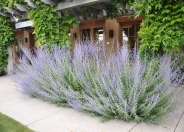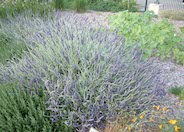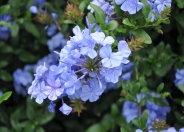
Common name: Chinese Wisteria
Botanical name: Wisteria sinensis
This deciduous vine can quickly and aggressively reach 30' and wide, depending on conditions. It bears rounded clusters of strongly fragrant flowers which open more or less all at once. Cultivars have blue, pink, white, purple or lavender colors, attracting hummingbirds in spring, followed by leafing out of foliage which are usually leaflets, followed by velvety, long, drooping pods. This vine can tolerate full sun to part shade, preferring well draining, rich, moist soil. But it is very reliable and can take drought conditions if established. It looks great in containers and even as a bonsai specimen.

Common name: Russian Sage
Botanical name: Perovskia x atriplicifolia
This broad perennial will grow 3'-6' tall and has small, grey-green leaves with blue-violet flowers that bloom in the summer. Foliage is aromatic if brushed against it. Also known as Azure Sage.

Common name: Goodwin Creek Grey Lavender
Botanical name: Lavandula 'Goodwin Creek Grey'
Lavandula 'Goodwin Creek Gray' is an evergreen shrub. This dense foliaged plant grows to 2.5'-3' high and 3'-4' wide. Foliage is silvery grey that are toothed at the tips. Deep violet-blue flowers appear above foliage from spring to late fall. This fragrant plant does best in full sun with well draining, alkaline soil. It needs regular watering when getting established, then occasional and then extra during hot spells. Flowers are great for bouquets and vase arrangements. This plant looks great in rock gardens, borders and containers.

Common name: Cape Plumbago
Botanical name: Plumbago auriculata
Plumbago auriculata is an evergreen, climbing shrub native to South Africa that has been introduced in tropical and subtropical climates of Europe, Asia, Africa and the Americas. It is widely cultivated as an ornamental, and is used in traditional medicine and as a source of dye. It has escaped from cultivation and become naturalized outside of its native range.